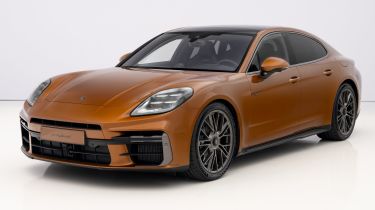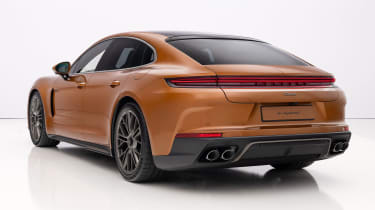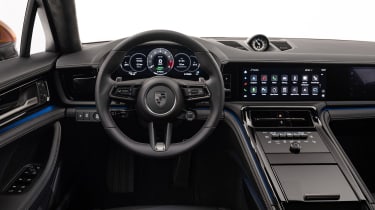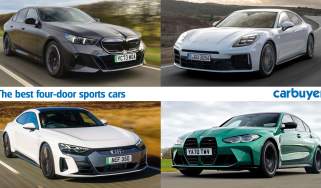New 2024 Porsche Panamera – new looks, interior, and Turbo E-Hybrid model
Four-door luxury Porsche gets a makeover for 2024, with new engines, tech and styling
- New exterior and interior – plus new tech
- Turbo E-Hybrid model joins the range
- Starts from £79,500, available now
In a world of high-performance electric cars and luxury SUVs, the current Porsche Panamera seems almost old-school, with its range of V6 and V8 engines under sleek, coupe-esque bodywork. Despite the introduction of the Porsche Taycan in 2019, an EV of similar size and shape, Porsche has maintained the Panamera in their lineup as the flagbearer for ultimate four-door, four-seater luxury.
Now, Porsche has deemed it time to upgrade the Panamera, and has revealed the new, fourth-generation model, complete with restyled bodywork, the latest interior tech and a new powertrain option with the Turbo E-Hybrid. Three Panamera models have been announced at launch; the aforementioned Turbo E-Hybrid for £141,400, and the entry-level V6 Panamera and Panamera 4, starting at £79,500.
New Porsche Panamera exterior design
The new Porsche Panamera retains the elongated coupe body shape present since the first model debuted back in 2009. As seen throughout its history, Porsche prefers an evolutionary approach when it comes to exterior design, and the new Panamera certainly fits this theme. Whilst the proportions are the same as the current model, every body panel (minus the door skins) is new, and you’ll notice the sharper, more aggressive detailing that appeared on the facelifted Cayenne SUV earlier this year.
Up front, the LED headlights are squarer than before, and the bumper has been redesigned, with a new air intake above the number plate. The rear has been updated too, with a wider rear window, a restyled bumper with hints of 911 GT3, and a simpler horizontal light bar. Centre-lock wheels are now an option for the Turbo E-Hybrid, alongside traditional alloys ranging from 19 to 21-inches in size. We’re glad to see that the Turbo E-Hybrid model retains the party-piece, electronically unfolding rear spoiler found on the current Turbo models.
The Turbo E-Hybrid gets some minor aesthetic tweaks too, which Porsche says will make their way to other Turbo models across its entire lineup, in an effort to visually separate them from their less powerful siblings. The wheels, bumper trim, badging and window surround are finished in a titanium colour, and there’s a monochrome Porsche crest on the nose.
New Porsche Panamera interior design
We love the cabin of the current-generation Panamera and, thankfully, the new model hasn’t deviated far, with the only updates being relatively minor. It’s a cleaner layout, the drive selector having migrated from central console to dashboard to free up space, and the array of touch-sensitive controls found on the current model has been simplified.
The biggest change is found behind the steering wheel – out goes the traditional rev-counter and pair of screens, in comes a new digital 12.6-inch curved instrument cluster. It’s not as large as the 16.8-inch item found on the Taycan, but will surely provide more functionality over the current Panamera. The passenger doesn’t have to miss out on the fun though – there’s a new optional 10.9-inch display for them too.
New Porsche Panamera powertrain
Porsche has so far announced two powertrain options for the new Panamera. First up is a 2.9-litre twin-turbocharged V6, found under the bonnet of the entry-level Panamera and Panamera 4 models, the latter featuring four-wheel drive. It puts out 348bhp – a handy 23bhp increase over the current generation – and is good for a 0-62mph time of 5.1 seconds in the regular Panamera, or 4.8 seconds in the four-wheel drive variant.
However, if it’s Autobahn-crushing speed you’re after, you’ll want to opt for the Turbo E-Hybrid model. A twin-turbocharged 4.0-litre V8 and electric motor combine to provide seriously more firepower, totalling 671bhp – identical to the current Turbo S E-Hybrid model. The system uses a 29.4kWh battery pack, helping to launch the Turbo E-Hybrid to 62mph in 3.2 seconds and reach 195mph flat-out. Drive sensibly, however, and you can cruise up to 62 miles on pure electric power too.
The new Panamera is based on the same platform as the current model, sharing its underpinnings with the Bentley Continental GT and Flying Spur, and all models use a new dual-clutch automatic gearbox, or ‘PDK’ in Porsche-speak. Porsche is keen to highlight their new suspension options which they hope will improve the Panamera’s ability to provide both luxurious comfort and responsive handling.
As standard, all Panameras will be fitted with a dual-chamber air suspension system. Upgrading to a hybrid model allows buyers to option a new active air suspension system that does away with the need for anti-roll bars. As well as improving ride and handling, this system can raise and lower the car to make getting in and out of the Panamera’s low body that little bit easier.
New Porsche Panamera price and availability
The range kicks off with the base Panamera starting at £79,500, the four-wheel drive Panamera 4 is likely to cost a few thousand pounds more. Porsche is notorious for their extensive and pricey options list, so expect the starting price to creep up once you’ve picked out a few extras.
The other model available is the Turbo E-Hybrid, which commands a significant premium at £141,400. Both models can be ordered now and the first UK deliveries are scheduled for spring 2024.
We expect Porsche to expand the Panamera lineup in the near future, with cheaper hybrid models and sportier S and GTS variants too. Those hoping for the ‘Sport Turismo’ estate model to return, however, will be left disappointed, with Porsche deciding that the demand outside of Europe isn’t big enough for it to continue in production.
Make sure to read our in-depth review of the current Porsche Panamera...
Recommended
Most Popular

Suzuki’s new 10-year warranty is free – here’s how to get it

Omoda E5 targets rivals: now with zero deposit and APR
Tips & advice

Car dashboard warning lights: what does each symbol mean?

Electric car charging stations: public networks, charger types, apps and maps












